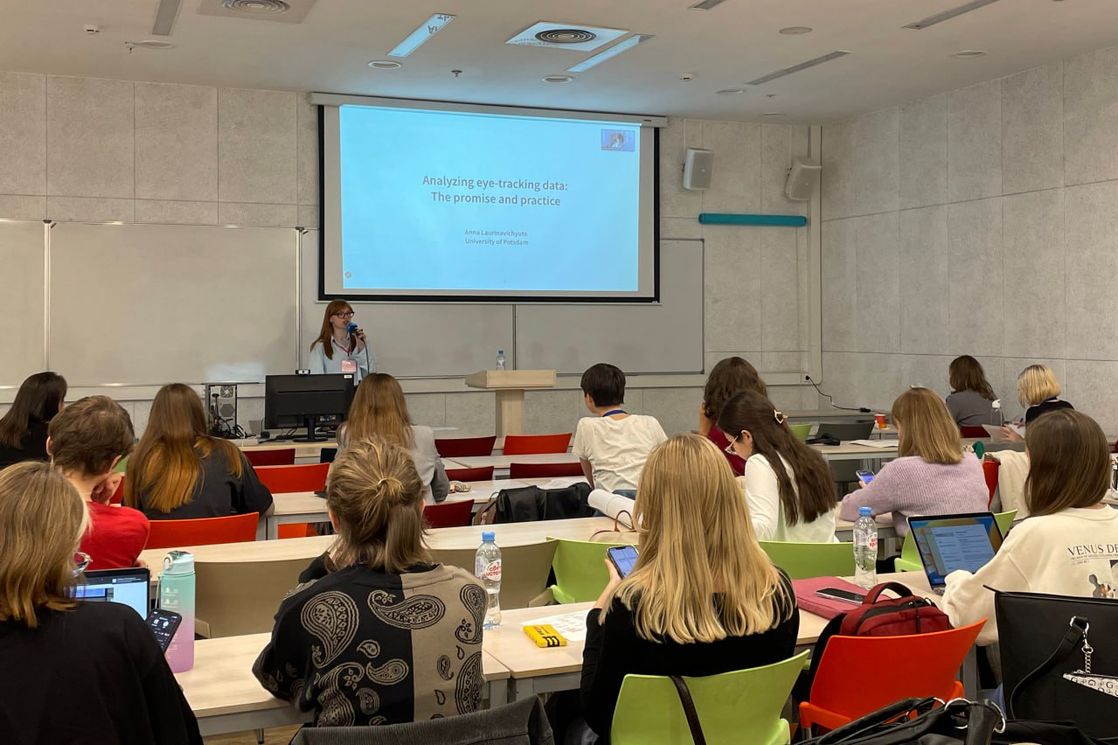- A
- A
- A
- ABC
- ABC
- ABC
- А
- А
- А
- А
- А
HSE University Holds 10th Summer School ‘Eye-tracking in the Lab and Beyond’
© HSE University
This year, more than 100 students from Russia and abroad took part in the 10th summer neurolinguistic school, ‘Eye-tracking in the Lab and Beyond’. The school is held annually by the HSE Center for Language and Brain. Leading experts spoke about advanced developments and research in the field of video-oculography.
Video-oculography, or eye-tracking, is a modern research method that allows scientists to record eye movements using powerful equipment including special portable glasses equipped with video cameras.
HSE Center for Language and Brain is one of the leading Russian scientific organisations engaged in research within the field of video-oculography. Since opening in 2018, the centre has conducted multiple studies with the participation of children and adults, as well as speakers of rare languages, such as Adyghe and Tuyuk. In addition, the centre’s video-oculographic studies have made a great contribution to the study and development of methods for correcting reading problems in children.

Anastasia Lopukhina, researcher at the University of London, presented an overview of recent studies on eye movement during reading in children. Studies have shown that the transparency of spelling affects the speed at which children learn to read. In addition, Anastasia talked about whether TV subtitles in their native language can help children develop their reading skills faster.
Irina Sekerina, a researcher from New York University, spoke about experiments which register eye movements using a webcam. This new methodology gained particular popularity during the COVID-19 pandemic, because it allows scientists to conduct research and collect data online without using expensive equipment. Despite the fact that the methodology has a number of limitations, its accessibility has great potential for conducting psycholinguistic research.
The report of Svetlana Alekseeva, senior researcher at the Institute for Cognitive Studies of St. Petersburg State University, was devoted to the study of eye movements for testing Cyrillic fonts, including the recently developed Cyrillic LexiaD font adapted for people with dyslexia.
On the second day of the school, Anna Izmalkova, research fellow at HSE Centre for Cognition & Decision Making, spoke about eye movement research in the field of visual searches and problem solving strategies. Based on the analysis of eye movement patterns and mistakes made, researchers can conclude what strategy a person uses when learning new words.
Anna Laurinavichyute, a postdoctoral researcher at the University of Potsdam, presented a report on traditional methods of analysing and processing video-oculographic data, as well as on new, more accurate and complex approaches that will improve the quality of video-oculographic research.
The report of Soroosh Shalileh, research fellow at the Center for Language and Brain, head of the Vision Modelling Laboratory, was devoted to the diagnosis of dyslexia based on machine learning and eye movement analysis. This diagnostic method has an advantage over traditional screening, which may require a lot of time and the involvement of highly qualified specialists, so its use should lower the age at which dyslexia is detected.
Representatives of ‘Neuroiconics’ made a presentation ‘From simple to complex. Modern solutions in the field of video-oculography in science, education, medicine and neuromarketing’ and demonstrated modern video oculographs.

During the school, Anna Izmalkova and Tatiana Ledneva, research assistant at HSE Centre for Cognition & Decision Making, held a workshop on working within the ‘Eye Movement Modeling Example’ paradigm. This approach is widely used to improve the efficiency of knowledge transfer during interaction between an expert and a novice in an educational context.
Elena Gorbunova, Head of HSE Laboratory for Cognitive Psychology of Digital Interface Users, spoke about the use of video-oculography in UX research. This method can be used to determine patterns of user behavior — for example, to determine a strategy for finding information or to identify what exactly the user focuses on while working with a particular interface.

‘It is important for us that the participants of the school were able to learn more about the areas of work of the Center for Language and Brain and talk about their research in the field of video-oculography. The great interest in this area confirms its relevance, and together we will make many more important discoveries,’ said Olga Dragoy, director of the Center for Language and Brain.
The school was held with the support of the HSE Human Capital Multidisciplinary Research Centre.